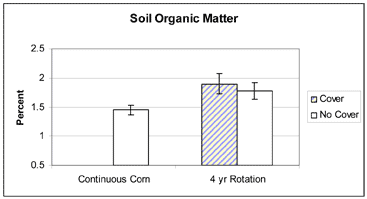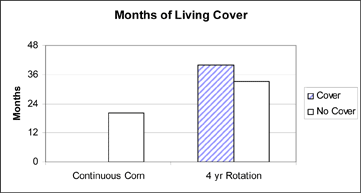Soil organic matter in a continuous corn cropping system
Editor’s note: This article is from the archives of the MSU Crop Advisory Team Alerts. Check the label of any pesticide referenced to ensure your use is included.
Soil organic matter (SOM) plays a critical role in fertility, water holding capacity, aggregate stability, tilth, and overall soil quality. It has been estimated that 50 percent of the SOM of most soils was lost in the first 100 years after the agricultural conversion of prairies and savannahs. A major goal of the USDA/NRCS has been to decrease soil erosion through practices such as reduced tillage, contour farming, grassed waterways, and buffer strips. These techniques have been instrumental in saving billions of tons of topsoil and have helped conserve SOM levels across the United States, especially on vulnerable lands.
Recently, the predominant cropping system in the Midwest (a corn-soybean rotation) has been under scrutiny in regard to the potential mining of SOM and has been questioned for its overall sustainability. The argument has been made that continuous corn, because of its large volume of stover return, can build SOM. As corn acres increase in response to market demands, the question arises “How will this influence SOM?”
Surprisingly, results from a long term rotation experiment initiated in 1993 at the Kellogg Biological Station indicate that SOM has not increased under a continuous corn cropping system during the past 15 years, but rather has increased for a four-year rotation of corn-corn-soybean-wheat (see Figure 1).
Figure 1. Soil organic matter levels in a continuous corn cropping system versus a four-year rotation during the past 15 years.

In 1993, this sandy loam soil had 1.5 percent organic matter. After 15 years, SOM has remained the same for the continuous corn cropping system; however, there is a significant increase in SOM due to crop rotation; and a trend for increased SOM for soil receiving cover crop inputs.
Here we explore several possible explanations for this observation: A) microorganisms in low organic matter soils (1.5 percent SOM) may be carbon limited and have a greater propensity to degrade corn residues; B) diversity and quality of biomass inputs may contribute to carbon sequestration; C); greater living cover exists in the rotation (especially when using cover crops) compared with continuous corn (see Figure 2); and D) corn grown in northern latitudes becomes source limited and partition more dry matter to grain.
Figure 2. Months of continuous living cover during a four-year period.

In regard to explanation C, a corn crop only has living roots in the soil for about five months per year, or 20 months over a four-year period. A corn-corn-soybean-wheat rotation has living cover for about 33 months, and adding cover crops such as interseeding crimson clover into corn and frost-seeding red clover into wheat provides living roots for a total of 40 months. We believe that continuous living cover likely plays a role in building SOM over time.
In regard to explanation D, source limitations, such as sunlight, lead to a physiological response of corn where more kernels are set than can be filled, and in an attempt to fill those kernels the plant is forced to cannabolize dry matter from the leaves and stalks to make grain. In 2006, the continuous corn plots at the Kellogg Biological Station produced 159 bu/A of corn with 135 lbs of N/A. The harvest index of this crop, which is the ratio of the amount of grain divided by the entire above ground plant biomass, was 59 percent (many working agricultural models use a value of 50 percent for harvest index). A high harvest index directly reflects the increased partitioning of dry matter from the leaves and stalks to the grain. Therefore due to light limitations in northern states, continuous corn cropping systems return less stover than is generally expected and this may be part of the reason why SOM has not increased in the continuous corn plots over the past 15 years.
Today, with the high price of organic corn, there may be some temptation to grow second year corn. However, we need to remember the benefits of crop rotation, such as improved soil fertility, reduced soil erosion, breaking pest cycles (weed, disease, and insect problem), and spreading the workload. These results from the Living Field Laboratory demonstrate the need for long-term research studies to quantify the accumulative benefits of both crop rotation and the use of cover crops on SOM.



 Print
Print Email
Email




